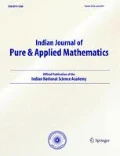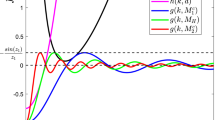Abstract
In this paper, considering the strategy of integrated Pest Management (IPM), a class of two-prey two-predator system with the Ivlev-type functional response and impulsive effect at different fixed time is established. By using impulsive comparison theorem, Floquent theory and small amplitude perturbation skill, the sufficient conditions for the system to be extinct of prey and permanence are proved. Moreover, we give two sufficient conditions for the extinction of one of two prey and remaining three species are permanent. Numerical simulation shows that there exist complex dynamics for system, such as symmetry-breaking pitchfork bifurcation, periodic doubling bifurcation, chaos, periodic halving cascade. Lastly, a brief discussion is given.
Similar content being viewed by others
References
P. DeBach, Biological control of insect pests and weeds, New York: Reinhold, 1964.
J. C. Van Lenteren, Measures of success in biological control of anthropoids by augmentation of natural enemies, Kluwer Academic Publishers, 2000.
J. Grasman, O. A. Van Herwaarden and L. Hemerik, ect, A two-component model of host-parasitoid interactions: determination of the size of inundative releases of parasitoids in biological pest control, Math. Biosci., 169 (2001), 7–16.
D. Dent, Integrated pest management, London: Chapman & Hall, 1995.
S. Y. Tang, Y. N. Xiao, L. S. Chen and R. A. Cheke, Integrated pest management models and their dynamical behaviour, Bulletin of Mathematical Biology, 67 (2005), 115–135.
Z. J. Liu and R. H. Tan, Impulsive harvesting and stocking in a Monod-Haldane functional response predator-prey system, Chaos. Soliton. Fractal., 34 (2007), 454–464.
B. Liu, Y. J. Zhang and L. S. Chen, The dynamical behaviors of a Lotka-Volterra predator-prey model concerning integrated pest management, Nonlinear Analysis: Real World Applications, 6 (2005), 227–243.
D. D. Bainov and P. S. Simeonov, Systems with impulse effect: Stability, Theory and Applications, Ellis Horwood series Limited, Chichester, 1989.
D. D. Bainov and P. S. Simeonov, Impulsive differential equations: periodic solutions and applications, Longman Group UK Limited, 1993.
G. Z. Zeng, L. S. Chen and L. H. Sun, Complexity of an SIR epidemic dynamics model with impulsivevaccination control, Chaos. Soliton. Fractal., 26 (2005), 495–505.
B. Shulgin, L. Stone and Z. Agur, Theoretical examination of the pulse vaccination policy in the SIR epidemic model, Math. Comput. Modelling, 31 (2000), 207–215.
A. Lakmeche and O. Arino, Bifurcation of non trivial periodic solutions of impulsive differtial equations arising chenmotherapeutic treatment, Dyn. Contin. Discrete Impuls. syst., 7(2) (2000), 265–287.
S. Y Tang and L. S. Chen, Density-dependent birth rate, birth pulses and their population dynamic consequences, J. Math. Biol, 44(2) (2002), 85–99.
R. M. May, Necessity and chance: deterministic dhaos in ecolgy and evolution, Am. Math. Soc., 32 (1995), 291–308.
W. M. Wang, H. L. Wang and Z. Q. Li, Chaotic behavior of a three-species Beddington-type system with impulsive perturbations, Chaos. Soliton. Fractal, 37(2) (2008), 438–443.
G. R. Jiang, Q. S. Lu and L. N. Qian, Chaos and its control in an impulsive differential system, Chaos. Soliton. Fractal, 34 (2007), 1135–1147.
G. Y. Chen, Z. D. Teng and Z. Y. Hu, Analysis of stability for a discrete ratio-dependent predator-prey system, Indian J. Pure Appl. Math., 42(1) (2011), 1–26.
V. S. Ivlev, Experimental ecology of the feeding of fishes, New Haven, CT: Yale University Press, 1961.
J. W. Feng and S. H. Chen, Global asymptotic behavior for the copeting predator of the Ivlev-type, J. Math. Appl., 13(4) (2000), 85–88.
J. Sugie, Two-parameter bifurcation in a predator-prey system of Ivlev type, J. Math. Anal. Appl., 217(2) (1998), 349–371.
Z. Y. Xiang and X. Y Song, The dynamical behaviors of a food chain model with impulsive effect and Ivlev functional response, Chaos. Soliton. Fractal., 39(5) (2009), 2282–2293.
L. Wang and X. L. Fu, A new comparison principle for impulsive differential systems with variable impulsive perturbations and stability theory, Comput. Math. Appl., 54(5) (2007), 730–736.
Author information
Authors and Affiliations
Corresponding author
Additional information
This work is supported by Guangxi Science Foundation (No. 0575092), Natural Science Program of Anhui Higher Education Institution under Grant (No. KJ2010B164, KJ2012Z382), and Major Project of Hefei Normal University under Grant (No. 2010KJ04ZD).
Rights and permissions
About this article
Cite this article
Wu, X., Du, W., Pan, G. et al. The dynamical behaviors of a Ivlev-type two-prey two-predator system with impulsive effect. Indian J Pure Appl Math 44, 1–27 (2013). https://doi.org/10.1007/s13226-013-0001-3
Received:
Revised:
Accepted:
Published:
Issue Date:
DOI: https://doi.org/10.1007/s13226-013-0001-3




